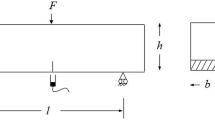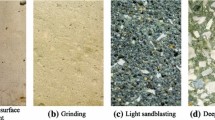Abstract
Fibre reinforcement is one of the effective ways of improving the properties of concrete. However, current studios on fibre -reinforced concrete (FRC) have focused mainly on reinforcements with steel and glass fibres. Thin paper reports on an experimental programme on the properties of various synthetic fibre reinforced cementitious composites and the properties of the reinforcing fibres. Acrylic, polyester, and aramid fibres were tested in uniaxial tension, both in their original state as we!! as after ageing in nerO*nL Samples of these fibres were found to lose varying amounts of strength with time, depending on the ageing temperature. Two different test methods were used to measure the fibre-cement interfacial bond strength. The tensile properties of concrete reinforced with acrylic, nylon, and aramid fibres, in the form of random distribution or unioxial alignment, were studied by means of three different tests: compact tension, flexural, and splitting tensile tests. The properties of concrete, particularly that of apparent ductility, were found to be greatly improved by the inclusion of such fibre reinforcement.
Similar content being viewed by others
References
J. B. Scalzi, paper presented at the Specialty Conference on Highway Infrastructures: Opportunities for Innovation, Leesburg, Virginia, July 1985.
C. E. Stubig, “Highway Infrastructure: The Need to Balance Its Research Agenda”, prepared as part of the 1985 Washington Internships for Students of Engineering (WISE) Program (1985).
H. G. Klos, in “RILEM Symposium 1975: Fibre Reinforced Cement and Concrete” edited by A. Neville (Construction Press, Lancaster, 1975) p. 259.
ACI Committee 544, “State-of-the-Art Report on Fibre Reinforced Concrete”, ACI 544.18-82, ACI Manual of Concrete Practice, Part 5 (ACI, Detroit, 1986).
M. A. Ali, A. J. Majumdar andD. L. Rayment, in “The Properties of Fibre Composites” Conference Proceedings, National Physical Laboratory (IPC Science and Technology Press, Guildford, Surrey, 1971) p. 27.
P. L. Walton andA. J. Majumdar,J. Mater. Sci. 13 (1978) 1075.
H. Krenchel andH. W. Jensen, in “Fibrous Concrete” Symposium Proceedings, London, 1980 (The Construction Press, Lancaster, 1980) p. 87.
G. R. Jakel, US Patent 3 899 344 (1975).
S. Akihama, T. Suenaga andT. Banno,Int. J. Cement Compos. Lightweight Concr. 8 (8) (1986) 21.
ASTM Standard A 820: “Standard Specification for Steel Fibre Reinforced Concrete” (ASTM, Philadelphia, 1986).
ASTM Standard C 1018: “Test Method for Flexural Toughness of Fibre Reinforced Concrete (Using Beam with ThirdPoint Loading)” (ASTM, Philadelphia, 1986).
ACI Committee 544, “Guide for Specifying, Mixing, Placing, and Finishing Steel Fibre Reinforced Concrete”, ACI 544.3884, ACI Manual of Concrete Practice, Part 5 (ACI, Detroit, 1986).
D. R. Lankard, in “RILEM Symposium 1975: Fibre Reinforced Cement and Concrete” edited by A. Neville (Construction Press, Lancaster, 1975) p. 3.
J. F. Ryder,ibid.in “ p. 23.
C. D. Johnston,Composites 13 (1982) 113.
D. S. Lyle, in “Modern Textiles” (Wiley, New York, 1976) p. 44.
D. J. Hannant,Mag. Concr. Res.,35 (125) (1983) 197.
P. Bartos,Int. J. Cement Compos. 3 (3) (1981) 159.
C. C. Chamis, “Mechanics of Load Transfer at the Fibre/Matrix Interface”, NASA Technical Note: NASA TN D-6588 (NASA, Washington D.C., 1972).
S. Mindess andJ. F. Young, “Concrete” (Prentice-Hall, Englewood Cliffs, N.J., 1981) p. 633.
ACI Committee 544, “Measurement of Properties of Fibre Reinforced Concrete”, ACI 544.28-78, ACI Manual of Concrete Practice, Part 5 (ACI, Detroit, 1986).
Y. Wang, SM thesis, Massachusetts Institute of Technology (1985).
Y. Wang andS. Backer in preparation.
ASTM Standard E 399: “Test for Plane-Strain Fracture Toughness of Metallic Materials”, (ASTM, Philadelphia, 1986).
V. C. Li, in “Application of Fracture Mechanics to Cementitious Composites”, edited by S. P. Shah (Martinus Nijhoff, Dordrescht, 1985) p. 431.
V. C. Li, C. M. Chan andC. Leung,Cement Conc. Res. 17 (1987) 441.
Author information
Authors and Affiliations
Rights and permissions
About this article
Cite this article
Wang, Y., Backer, S. & Li, V.C. An experimental study of synthetic fibre reinforced cementitious composites. J Mater Sci 22, 4281–4291 (1987). https://doi.org/10.1007/BF01132019
Received:
Accepted:
Issue Date:
DOI: https://doi.org/10.1007/BF01132019




